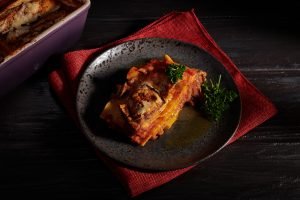Mediterranean Diet Staples- Vegetables
Your mom was right when she said, “eat your vegetables”. Vegetables are a staple in a Mediterranean diet for good reason. People living in Mediterranean regions take advantage of the climate and grow a variety of vegetables. Low in calories and nutrient dense, most veggies pack a hefty dose of vitamin C, potassium, fiber and phytochemicals that help prevent heart disease, cancer and other chronic illnesses. The staples of a Mediterranean diet can be used in multiple types of cuisine. Below are a few to include in your diet regularly:Broccoli- while I didn’t love broccoli as a kid, it’s my favorite vegetable now. Broccoli originated in the eastern Mediterranean and Asian minor. It is delicious when roasted with a little olive oil and garlic, sautéed and added to pasta or made into broccoli gratin or soup.
Kitchen hack: Serve broccoli both cold and hot to have variety with the same vegetable during the week. Serve it cold in a salad the first few days when it is fresh, then steam it later in the week.
Eggplant- eggplant is a staple of Mediterranean cuisine. Though technically a fruit (as it contains seeds), eggplant is low in calories and a good source of fiber. It is often used in ratatouille, a colorful vegetarian stew.
Kitchen hack: You do not need to soak eggplant before using it as so many recipes dictate. Slice, bake, and go! You can use it for a sandwich filling, stir fry dishes, salads, kabobs, pasta, and soups.
Garlic- garlic is characteristically found in Mediterranean cuisine, but how much is used differs from country to country. Eastern Middle Eastern countries may pair garlic with yogurt for Tzatiki sauce while it may be included with eggs and olive oil to make aioli.
Kitchen hack: Fresh garlic is always great but you can also buy freeze-dried garlic and granulated garlic, Use one or more to layer the garlic flavor in a dish. Do not store garlic in oil because it contains botulism spores that may thrive in an anaerobic environment. Don't want to chop? Simply slice it very thin and it will impart a nice flavor while being palatable.
Onions- multiple varieties of onions are used in Mediterranean dishes. From red to white onions, these add flavor, fiber, color and texture to pasta, salad, sauce and soup. Onions may be chopped and used raw in a salad or sautéed in olive oil for main dishes.
Kitchen hack: Stock up on a variety of onions including leeks, scallions, sweet onions, shallots, and red onions. Use them to add a pungent flavor to salads, salsas, sandwiches, soups, and pastas.
Peppers- Peppers of all kinds are popular in Mediterranean cuisine. They add color, texture and flavor to any dish. From breakfast to dinner and in between, peppers can be added to eggs, grain dishes, soups, stews or as a snack with hummus. Red, orange and yellow are higher in vitamin C and sweeter than green bell peppers.
Kitchen hack: Many stores have packages of mini peppers in a variety of colors. Experiment with sweet and hot peppers as you make salads, salsa, or baked items. Simply slice them and top any of your baked entrees with peppers.
Spinach- the term Florentine is a culinary term used to denote the region of Florence in Italy and is typically associated with foods including spinach. Spinach is highly versatile and can be used raw in salads or in wraps or sautéed and added to pasta, risotto or other dishes.
Kitchen hack: Many people think of spinach as a salad green. But it is delicious when steamed or when added at the last minute to pasta. It gives the look of fresh basil to pasta, soups, and pizza.
Tomatoes- these ruby red gems add color, texture and taste to nearly any dish. Canned varieties have more bioavailable lycopene- a flavonoid found in cooked or processed tomatoes. Add fresh tomatoes to salads, sandwiches, pizza or as a snack. Stewed or diced tomatoes can be added to sauce, soup or stew. There are multiple varieties to choose from.
Kitchen hack: If you purchase cherry or other small-shaped tomatoes at the store you can use them so many ways with little effort. Add them to salads, eat them for a snack, roast them and grind into salsa or pasta sauce.

 Submitted by Lisa Andrews, MEd, RD, LDHere is a recipe for an eggplant lasagna that can be made easily in a loaf pan. It uses eggplant in place of ricotta cheese so it is a lot lighter since it is lower in fat and calories by at least 50%. It tastes more satisfying, too!Download Handout Eggplant LasagnaMediterranean Recipes - All[shopify embed_type="collection" shop="nutrition-education-store.myshopify.com" product_handle="mediterranean-diet"][shopify embed_type="collection" shop="nutrition-education-store.myshopify.com" product_handle="menu-planner"]
Submitted by Lisa Andrews, MEd, RD, LDHere is a recipe for an eggplant lasagna that can be made easily in a loaf pan. It uses eggplant in place of ricotta cheese so it is a lot lighter since it is lower in fat and calories by at least 50%. It tastes more satisfying, too!Download Handout Eggplant LasagnaMediterranean Recipes - All[shopify embed_type="collection" shop="nutrition-education-store.myshopify.com" product_handle="mediterranean-diet"][shopify embed_type="collection" shop="nutrition-education-store.myshopify.com" product_handle="menu-planner"]


